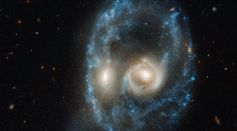Tags: Stars
Prebiotic Ingredient: How Scientists Discovered a Precursor of Life Around a Young Star

A New Study on Theia 456 Reveals Hundreds of Stars Born Almost at the Same Time
Astronomers Rewrite the History of the Milky Way Galaxy

How To Tell Time Without Using Clocks

Astronomers Want to Build Giant Telescope on Moon to See The Very First Stars

The South Pole Wall: 100 Million Billion Stars Are Found Hiding in the Milky Way

Evidence of Stars Born Elsewhere Suddenly Merged With the Milky Way

5 Best High-Tech Beginner-Friendly Telescopes for Viewing Planets and Stars
NASA Hubble Space Telescope Captures New Images of the 'Pillars of Creation' Surrounded by New Born Stars

Hubble Captures a Ghoulish Image Produced by Twin Galaxies Colliding
Blob Of Star Gas Spotted by The Hubble
Ancient Star Offers A Glimpse Of The Beginning of The Universe
The Amazing 3-D Printing of 1.7 Billion Stars
Research Team Discovers Two New Earth-Like Planets near Teegarden’s Star
The Star that Astronomers Say “Should Not Exist”
Tiny Planet Shows What Earth Could Turn Out To Be
Stars List Show Potential New Planets in Existence
The Milky Way’s Mid-section is Full of Relic-like Stars
'It's A Twin!’ Sun & Other Stars In The Universe Found Out To Be Born With A Twin, Evidences Found Through Perseus Cloud
Milky Way Future Revealed By ESA Gaia Mission Video: Travel Through 5 Million Years
Most Popular

Extreme Weather Science Reveals How Climate Change Patterns and Global Warming Transform Earth's Weather

What Causes Tornadoes and How They Form: Tornado Science Explained for Extreme Storms

Why Pandemics Keep Happening: Pandemic Cycle and the Rise of Emerging Diseases

How Planets Form: Planet Formation and Protoplanetary Disks in Solar System Creation





